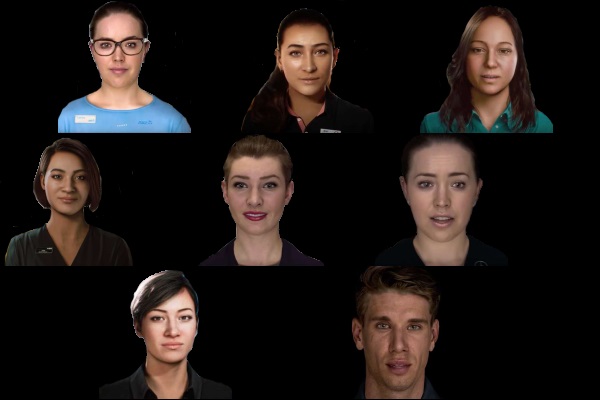Published on the 06/11/2018 | Written by Heather Wright

Uncanny belief that uncanny interactions will simplify anything…
Four New Zealand government departments have jumped on the band wagon of trials of digital assistants trying to improve customer experience.
The Ministry for Primary Industries, NZ Customs, Inland Revenue and the Ministry for Business, Innovation and Employment (MBIE) have been working with Datacom on the project to see if AI, fronted by a weird e-human, has the potential to make it easier for the business citizenry to interact with the government in complex multi-agency contexts.
The actual results are somewhat irrelevant. The PR spinoff has already paid its dues, which is more what is behind the uptake than any real service enhancement. This is more about marketing and entertainment. Surprisingly these things haven’t been released in a blockchain flavour (yet).
The latest digital assistant, Tai, MBIE’s statement enthuses, is ‘a 25-year-old New Zealander who can navigate his way through complex information across multiple government websites and provide you with answers to your questions in the blink of an eye’.
After a proof of concept completed in July, the agencies have been focusing the pilot on honey exporting ‘because it requires businesses to navigate across two government agencies – MPI and Customs’.
“We know that navigating complex exporting requirements across our two government agencies can be confusing, complicated and time consuming,” MPI and Customs say.
There was no accompanying suggestion there would be any simplification in the processes, despite the significant investments in the ‘Trade Single Window’ concept.
Business users from the apiculture and exporting community were able to ask export questions in natural language and receive responses, also in plain language.
The initiative is being coordinated as part of the government’s ‘Better for Business’ programme, which involves 10 agencies (MBIE as the lead, with ACC, Stats NZ, Worksafe NZ, NZTA, NZTE and Callaghan among the others involved) and was set up to improve the interaction between business and government.
Lisa Casagranda, Better for Business director, says “It’s a catalyst to improve the consistency and coordination between agencies and is an important step for government‘s future customer-facing digital channels and service delivery.
“By coordinating agencies around important business outcomes and innovating our service delivery models, we aim to make it easier and more seamless for businesses to deal with government.”
Presumably having a digital ‘human’ interface makes it easier for us to interact with a machine. MBIE, itself, says the objective of the proof of concept was to find out if conversational AI works in a cross-agency regulatory context and if businesses would be open to having a conversation with a machine to reduce their effort searching for information.
The findings? Not yet open for public consumption.
Refreshingly, Tai is a male after the march of female digital humans we’ve been seeing in recent months – Air New Zealand’s Sophie, ANZ’s Jamie, Mercedes Benz’ Sarah (all courtesy of Soul Machines) and Josie (ASB), Vai (Auckland Airport) and Kiri (Vodafone), along with another Sophie, this time for Money 20/20, all courtesy of FaceMe.
Tai, whose face we have yet to see, joins Vector’s Will, as one of few male digital assistants doing the rounds.
Here at iStart, we’re not sold on whether the business community is ready to trust any 25-year-old to be the ‘expert’ on all things government, let alone one that is digitally enabled.
We reckon there’s something a little weird with the growing crop of digi-sistants, and it’s not only that uncanny valley where they appear almost, but not quite, human with their movements, particularly in the lip department. It’s also that they all look the same, clearly modelled on the same person. Take a look at the images below of Jamie, Sophie V1 and Sarah.
Have a chat to Jamie at ANZ and then to Sophie at Air New Zealand (this PR spinner is yet to be let loose on an Air NZ domain). Once you’ve calmed down from the numbingly circular conversation with Jamie suggesting ‘here’s the link to click’ (thanks, I could have googled that) the two personas are interchangeable, on looks and voice (let’s hope Sophie comes with a sense of humour at least). In a world where we keep hearing that diversity and personalisation are so important, these assistants are suffering a bad case of copy-rexia.
 Our prediction: Tai will bear a striking similarity to Will.
Our prediction: Tai will bear a striking similarity to Will.
In Australia, the National Disability Insurance Agency’s Nadia project – one of the earlier digital virtual assistants, which garnered plenty of attention because of its use of Oscar winner Cate Blanchett as the voice of Nadia – stumbled, with the Turnbull government putting the kibosh on the assistant’s public debut after other high-profile IT incidents including the Census debacle, and robo-debt fiasco.
In August Marie Johnson, former head of technology at NDIA defended the Nadia project (developed by NDIA, Soul Machines, FaceMe and IBM), arguing that the programme should be reinstituted and run by NDIA as a strategic capability.
In a submission to the Senate Inquiry into the NDIA’s ICT systems, Johnson said the Nadia innovation started ‘first and foremost as a question of human rights’, providing augmentative and alternative communication and the ability for people to be able to receive and impart information and ideas on an equal basis.
For people with severe physical disabilities, communicating with a semi-intelligent avatar would seem to make some sense (although the keystrokes to get there are perhaps conveniently forgotten).
For your average warm blooded human? Not so much.






























